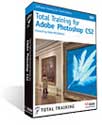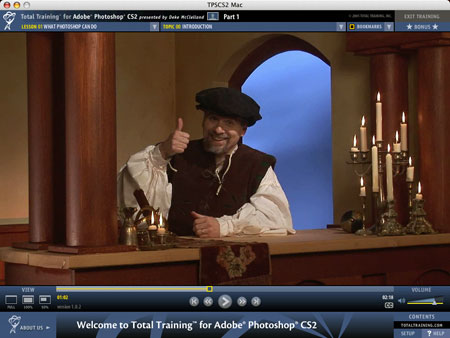
Total Training for Adobe Photoshop CS2
3-DVD package (21 hours 50 minutes)
Hosted by Deke McClelland
Total Training
$299 US (plus current student discounts from Total Training)
Deke is a hero. His Photoshop books and videos are the best. In this fifth edition of the popular Total Training for Adobe Photoshop series, Deke’s skills and experience combine for an excellent tutorial having potential value far greater than its hefty price tag.
First question: If you’re smart enough to know how to use the professional ($600 or thereabouts) version of Adobe Photoshop (as opposed to the under-$100 Adobe Photoshop Elements, or “free†iPhoto) why would you ever need to spend another $300 (or a bit less online) to learn how to use it?
Second question: Why not simply purchase a couple of Deke’s books, study quietly at your own pace, and save a few hundred dollars of your hardly-earned cash?
Answers: Directed audiovisual education can be very instructive, in an appropriate environment. Individuals who learn best this way would spend w-a-y more than $300 for private lessons or top-quality workshops.
Being a private Photoshop teacher, my students will be able to proceed much more quickly via Deke’s time-tested steps than another method, I predict, with or without my active participation. In a classroom or seminar, DVD training is a huge addition to the curriculum.
LET’S GET TECHNICAL
This 3-DVD package, called TPSCS2 by its publisher, contains 36 lessons, each with an average of eight incremental segments. Users can pick and choose, repeat, jump ahead, mix and match, bookmark particular episodes, adjust volume, and pause, all while working step by step alongside Deke’s instruction, assisted by the dozens of included image files.
Installation takes a couple of minutes, and requires a current version of QuickTime (5.0.2 or later), with a live Internet link recommended. With your own copy of Photoshop CS2 on your computer, Total Training’s installer contains three components: Project Files, the Training Application, and Presets (to allow your CS2 to be configured just like Deke’s software).

As with all Total Training videos, this one features a theme: “Invoking the spirit of the original Renaissance man, Leonardo DekeVinci†(complete with appropriate costume — see screen shot above). Once the actual lessons are underway, Deke is heard but not seen, allowing you to follow his mouse tracks and keystrokes in real time.
I chose Part 3, Lesson 2: “Curves, Shadows, and Highlights†as my trial lesson for this review, because I don’t yet spend much time using Photoshop’s powerful and somewhat scary Curves adjustment feature. On our TPSCS2 screen is a sepia-toned photo of an elephant, for our lighting instruction “when the Levels command and the Auto variations fail you,†says Deke.
Elephant has “hot spots†of overexposure above its eyes and on its forehead. Our goal is to turn it into an “accurate, continuous tone representation†— Deke’s language is always snappy and articulate — because “Auto Levels doesn’t do a darn thing.†Ditto for Auto Color. Doing an “Alt>Slide†from standard Levels demonstrates how much color is buried within the saturated black background channels, but midtone red channel tweaking in Levels doesn’t improve the overall photo. “What we need is Levels on steroids,†continues Deke.
During his talking and mousing, I’m pausing TPSCS2 to switch back and forth between the DVD application and Photoshop on my G4 iBook, not having two standard displays or one giant one. Sounds annoying, but it works efficiently.
We need more lighting adjustment points than Levels offers (it has three of them), Deke explains. He is human, we find out, because he always begins with Levels rather than Curves, just like other mortals. Keyboard command is Command (Apple) M for Curves, with its “brightness curve†diagonal line.
Colors can be “mapped,†or sent, from one brightness value to another, with Input being “from†and Output being “to†(not very easy to describe in text, but obvious on the screen). Deke demonstrates how the brightness curve has complete flexibility with regard to black, white, and gamma points, with “pinpoint precision control†over all colors in every image.
When your personal Snooze Alert kicks in, it’s time to stand up, take a break, check your email, flip through one of Deke’s many books, and resume your self-motivated Total Training when your eyelids are fully open again. Pace, coverage, and overall tone of TPSCS2 are geared toward quick-witted Intermediates, but:
Beginners will feel comfortable and welcome throughout, if they pledge to go slowly and proceed in small increments
And
Experienced users can always use fine-tuning of their skills, because even pros become lazy with familiarity (the $150 advanced DVD series has just been released, FYI)
Curves are not new to Photoshop CS2, but Adobe’s Bridge is, and it warrants 33 minute Lesson 2 of Part 1. After “Showing Off New Features,†Deke explains about using Bridge for “Managing Your Images,†including “Workspaces, Location Tracking, & Slide Shows,†all newly designed with Bridge in mind.
IN CONCLUSION — IT’S A WINNER
Seeing (and hearing) is believing, and I believe in Total Training for Adobe Photoshop CS2. Not all its features are active yet, so our rating reflects a little room for additional development (that’s not a criticism, merely a fact of release timing). MyMac.com and Nemo highly recommend TPSCS2 and award it 4.5 out of 5.
You can view sample material from the DVD on its web site, and the product comes with a 30-day money back guarantee. Total Training has confidence in their products!

Leave a Reply
You must be logged in to post a comment.